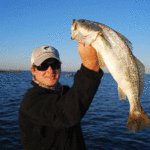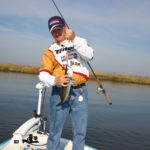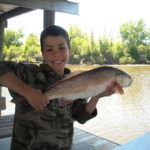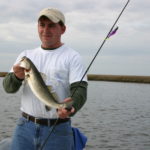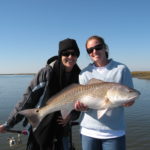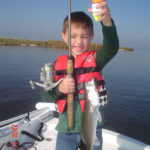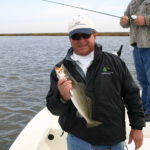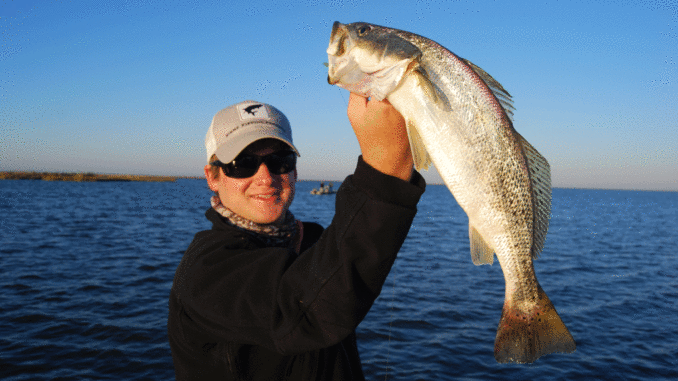
A change of tactics will put fish in the boat when Mother Nature gives you a high sky and dirty water.
Weather cycles pretty much make the fishing world go round in South Louisiana. The same cold fronts — along with the waning photoperiod — that drive speckled trout inland and the masses of white shrimp out also serve to sometimes violently flush the marsh when strong north winds make their way through the coastline.
Understanding the fish’s mentality as it pertains to the ups and down of barometric pressure and wind in the Hopedale/Delacroix area can go a long way toward turning a fruitless trip into a messy ice chest.
Dwayne Cooper finally took a look at the water he’d been avoiding the past five miles or so upon making the right turn at the bridge at the Ysycloskey bridge. The veteran Hopedale angler, who eschews closer venues to his St. Gabriel home, didn’t want to see what challenges lay ahead on this cold winter’s day — the only such outing he’d been able to fit into a tight schedule — until it was time to focus solely on them and not on the unexpected trailer-light issues he’d discovered two hours previous.
“But that’s just another thing to worry about. I try not to ever look at the water along the bayou until I get to the launch,” said Cooper, who’s been hauling boats of various sizes down I-10 to St. Bernard Parish for 14 years. “It started I guess when I was a kid when I was old enough to realize what water level and clarity meant to what kind of day we were in store for. There’s no sense getting in a bad mood until it’s time to get in a bad mood.”
Like most people, Cooper enjoys fishing for speckled trout in the fall and winter months. Just as long as the weather doesn’t act too much like winter.
“It’s the cold weather that sends these fish inside and away from all of that big water out there,” said Cooper, who currently totes out of a 20-foot Xpress bay boat. “This boat is OK for getting out there, but any 20-foot boat is a tough match for those squalls in the summertime. And any wind over 10 m.p.h. is good at turning me into a redfisherman.”
The water in Bayou LaLoutre was a chocolately brown that sent depression chills over me thinking of the prospects of eight hours on the water, which is what Cooper is known for, rain, shine or whatever. The wind blew straight out of the north at around 15 m.p.h. Not awful, but far from ideal in the interest of a full box of trout.
Undaunted, Cooper slammed the throttle down, and we sped toward the general direction of Lake Robin in what would prove to be a wide sweep in search of fishable water.
Forty five minutes later, a small bayou near Lake John proved worthy of a look. The clarity was just two clicks from depressing in the right direction, a level more than enough for Cooper, who’d grown weary of burning gas 20 minutes earlier.
“One of the reasons I like it down here this time of year is the proximity of the fish to the launch,” he said. “Things have come a long way since the summer when it was almost hard to justify a trip with the gas prices the way they were, but I like riding in my truck a whole lot more than riding in the boat when it’s cold like today.”
A quick look at the sounder revealed a predictable dropoff from the bank’s shelf to 11 feet of water in the curve of the unnamed bayou. Fish shapes speckled the screen, though Cooper dismissed them as “could be anythings.” What he liked was the sheer dropoff and the trickle of current that would allow him to thoroughly work the deeper water with a 3/8-ounce unpainted jighead and Norton Sand Eel Jr. in glow/chartreuse.
“With this color water, the fish need every bit of help they can get to get a line on this bait,” he said. “That’s why I like a 3/8-ounce head. It pushes a lot of water around when it’s stained like this and makes those little mud clouds when it’s clear and the fish want a little hop.”
The first spot produced one strike from either of us that managed to loose themselves after a few seconds, but the next similar area saw a few, cold fish coming over the gunnels. The bite was tough, especially for me who had mindlessly ignored the advice of Cooper to change my line to 10-pound-test for this trip.
“I’m not sure how many more bites you’ll get, but you’ll definitely feel them better,” said Cooper. “And if you’re like most people, you don’t change line enough.”
Good advice on both counts, which weighed on me even more as the count grew to 7-2, including a fat flounder, before petering out.
Charlie Thomason of Bayou Charters says keeping in mind a few things will go a long way, especially when 1) persistent southerly winds precede a front, 2) roaring northerly gusts directly after the blow push through or 3) a “severe clear” high pressure dome builds over the area following the front.
“This time of year, it’s windy a lot. But that doesn’t mean you can’t catch fish, especially the time immediately before a cold front,” Thomason said. “I generally shy away from taking charters when the wind gets too bad after a front, but that’s mainly because of the lack of experience of a lot of my customers.
“You can catch fish, but it’s not an easy learning curve in working the bait, feeling the fish bite and casting when there’s a 20+ mph north wind blowing and it’s cold and getting colder.”
Thomason gave a rapid-fire breakdown of fishing in and around cold fronts in the region.
“Prior to a front, nine out of 10 times, you’re going to have pretty strong south or southwest winds,” he said. “In our area, that either means the water’s going to be coming in (south wind) or going out (southwest). So you’ve got to look at your incoming and outgoing tide spots.
“The fish are going to be holding in the mouths of bayous and major passes such as the mouth of Lake Amadee, Bayou Batolo, the mouth of Lake Robin. On the other side, you’ve got places like the pass between Stump Lagoon and Magnolia.”
Brisk winds, even out of the dreaded southwest, are no reason to sit out a trip, according to Thomason.
“The fish will just sit there and let the bait come to them. The coming front will trigger them to feed. They’ll get right on the edges of the shallows where the deeper pass or bayou is tapering up,” said Thomason. “My deal is to fish the baits under a cork — we’re imitating shrimp that are coming through the passes and bayous — about a third way to whatever the depth of the water is. So in 4 feet of water, I’ll fish a foot and change down.
“When you work that cork, the fish can look up and get a good silhouette at the bait.”
For fish that really get the blood pumping, anglers might want to sacrifice quantity for quality and go with treble hooks.
“If you’re looking for more quality, you’ll want to fish topwaters and suspending baits. The reason for that is that when the fish get to be around 16 inches or better, they become more fin feeders,” said Thomason. “That’s not to say the bigger fish won’t eat a shrimp. But they’re not going to chase one like the smaller fish will. They’d rather sit and wait for a bigger meal they can subsist on for a while.”
Stiff north winds, as mentioned before, generally push Thomason toward rescheduling. But for those with some skins on the wall and who don’t mind a little cold, a day can definitely be made.
“If you’re fishing right when the front passes, you use the same techniques in the same areas. It takes a day or so for the water temperature to drop and the high pressure to push down on the fish to the point where they actually feel discomfort,” said Thomason “What you’ve got to figure out is boat positioning as the wind shifts.”
Bluebird conditions are by far the toughest and a little different from the suspending nature of fish in other areas when it’s the coldest. The difference is that these fish will bite in the Hopedale area should anglers stay after it.
“As the wind dies and the high pressure builds and pushes the water out and pushes down on the fish, they’ll move deeper to feel better,” said Thomason. “The stronger the pressure, the deeper the fish will go. On a 30.00 barometer reading, they’ll be around a half or two-thirds of the way down.
“What you can do with this is work your baits, depending on current, with a good natural fall. I carry 1/8-, ¼- and 3/8-ounce jigheads and experiment until I determine how to get that bait in front of them without a whole lot of movement. Just kind of swimming it with the current.
“When the pressure gets to around 30.50, the fish will just lock down on the bottom, just hugging the bottom. And they’re not going to be chasing anything. You want to throw upcurrent and just work it back and let the current tumble it down. No hopping, no twitching.
“What I’ve been doing lately with a lot of success is fishing a drop-shot. The hook is just above the sinker, about 4 inches. You just shake the rod a little bit to get it going in the current and let it tumble down. Again, you can experiment with weight to see what gives you the right action.”
When weather stabilizes, often just for a day or so prior to the next system’s passing, the trout will generally scatter from the deeper holes and fatten up for the leaner times. More predictable tides allow anglers to get where shrimp and birds will be making the spots where fish will be holding.
“Once the water comes back in a little and the wind starts blowing again, the fish will make a move back onto the flats. This is when it really pays to get out on the water early in order to see where the birds are working,” said Thomason. “They’ll show you the depth of the fish for the rest of the morning. Take notice of where they are and then when they shut down after an hour or so, you can say to yourself ‘I can go to 10 more spots like this and catch fish.’”
Cooper was good enough to let me suffer only a few more fish before tossing me a spool of 10-pound Big Game. And another four 13- to 17-inch trout hit the ice in the 20 minutes before I was done with the switch. It was a bargain at three times the price as we both began whacking fish as they hung on the bottom of another three or four drop-offs.
“Nobody likes fishing jerkbaits and topwaters more than I do, but this is a lot of fun, too,” said Cooper as he swung and missed on a bite as the bait fell down the drop-off.
The clicker on his belt loop read 29 as we neared the four-hour mark.
